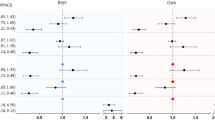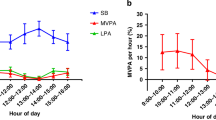Abstract
Background
This study examined the association between individual physical fitness (PF) components, overall fitness scores, and executive function (EF) indicators in preschoolers. Additionally, it explored the relationship between objectively measured physical activity (PA), sedentary behavior (SB), and EF.
Methods
This cross-sectional study included 241 preschoolers (121 males, 50%) aged 3–5 years from two different schools. Physical fitness was assessed using the PREFIT battery, which measures lower- and upper-body muscular strength (handgrip strength [HGS] and standing long jump [SLJ]), speed/agility (4 × 10 m), and cardiorespiratory fitness (CRF). The test scores for each student were standardized by age and sex. Individual z-scores were then calculated, and the sum of these z-scores constituted the overall PF. EF (including visual-spatial working memory, phonological working memory, inhibition, and cognitive shifting) was assessed using the one-on-one iPad-based Early Year Toolbox. Total PA, SB, and SB were objectively measured using a tri-axial GENEActiv Original accelerometer worn for six consecutive days.
Results
Preschoolers with higher overall PF showed significantly better performance in visual-spatial working memory (β = 0.574, p < 0.001), phonological working memory (β = 0.317, p < 0.001), inhibition (β = 0.379, p < 0.001) and cognitive shifting (β = 0.395, p < 0.001). Similarly, greater engagement in total PA was associated with higher scores in visual-spatial working memory (β = 0.179, p = 0.016), phonological working memory (β = 0.237, p = 0.036), and inhibition (β = 0.148, p = 0.045), which had higher scores on inhibitory control and working memory tasks.
Conclusion
These findings highlight the significant influence of PF and PA levels on cognitive performance. Therefore, educational and public health programs must implement strategies to encourage regular PA and improve PF. Such efforts could contribute to better cognitive development and overall health outcomes.
Impact
-
This study emphasizes the importance of physical fitness, particularly muscular strength, speed agility, and cardiorespiratory fitness, in supporting executive function (EF) development in preschool-aged children. Early childhood education policies should prioritize structured physical activity programs to enhance cognitive functions such as working memory, inhibition, and cognitive flexibility.
-
A direct inverse relationship between sedentary behavior and EF was observed. Limiting sedentary activities and encouraging movement in early childhood settings may yield significant cognitive benefits, suggesting that teachers and caregivers should promote more active environments for children.
-
The findings indicate that overall physical fitness supports cognitive abilities rather than isolated fitness components.
This is a preview of subscription content, access via your institution
Access options
Subscribe to this journal
Receive 14 print issues and online access
$259.00 per year
only $18.50 per issue
Buy this article
- Purchase on SpringerLink
- Instant access to full article PDF
Prices may be subject to local taxes which are calculated during checkout



Similar content being viewed by others
Data availability
The datasets generated during and/or analyzed during the current study are available from the corresponding author upon reasonable request.
References
Willoughby, M. T., Wylie, A. C. & Catellier, D. J. Testing the association between physical activity and executive function skills in early childhood. Early Child Res Q 44, 82–89 (2018).
Clark, S. et al. Cerebellar-subcortical-cortical systems as modulators of cognitive functions. Neuropsychol. Rev. 31, 422–446 (2021).
Sibley, B. & Etnier, J. The relationship between physical activity and cognition in children: A meta-analysis. Pediatr. Exerc Sci. 15, 243–256 (2003).
van der Niet, A. G. et al. Associations between daily physical activity and executive functioning in primary school-aged children. J. Sci. Med. Sport 18, 673–677 (2015).
Haapala, E. A. et al. Physical activity and sedentary time in relation to academic achievement in children. J. Sci. Med. Sport 20, 583–589 (2017).
Martinez-Vizcaino, V. et al. A cluster mediation analysis confirms the validity of the “Fat but Fit” paradigm in children’s cognitive function and academic achievement. J. Pediatr. 231, 231–238.e1 (2021).
Hogan, M. et al. The interactive effects of physical fitness and acute aerobic exercise on electrophysiological coherence and cognitive performance in adolescents. Exp. Brain Res 229, 85–96 (2013).
Nieto-López, M. et al. Relation between physical fitness and executive function variables in a preschool sample. Pediatr. Res. 88, 623–628 (2020).
Meijer, A. et al. Cardiovascular fitness and executive functioning in primary school-aged children. Dev. Sci. 24, e13019 (2021).
Stroth, S. et al. Physical fitness, but not acute exercise modulates event-related potential indices for executive control in healthy adolescents. Brain Res. 1269, 114–124 (2009).
Luo, X. et al. Association of physical activity and fitness with executive function among preschoolers. Int J. Clin. Health Psychol. 23, 100400 (2023).
Carson, V. et al. Systematic review of sedentary behavior and cognitive development in early childhood. Prev. Med. 78, 115–122 (2015).
Lau, P. W. C. et al. 24-Hour movement behaviors and executive functions in preschoolers: A compositional and isotemporal reallocation analysis. Child Dev. 95, e110–e121 (2024).
Syväoja, H. J., Tammelin, T. H., Ahonen, T., Kankaanpää, A. & Kantomaa, M. T. The associations of objectively measured physical activity and sedentary time with cognitive functions in school-aged children. PloS One 9, e103559 (2014).
NHANES Questionnaires, Datasets, and Related Documentation n.d. https://wwwn.cdc.gov/nchs/nhanes/Default.aspx (accessed September 5, 2023).
de Onis, M. et al. Development of a WHO growth reference for school-aged children and adolescents. Bull. World Health Organ 85, 660–667 (2007).
Cadenas-Sanchez, C. et al. Assessing physical fitness in preschool children: Feasibility, reliability and practical recommendations for the PREFIT battery. J. Sci. Med Sport 19, 910–915 (2016).
Howard, S. J. & Melhuish, E. An early years toolbox for assessing early executive function, language, self-regulation, and social development: Validity, reliability, and preliminary norms. J. Psychoeduc. Assess. 35, 255–275 (2017).
Migueles, J., Rowlands, A., Huber, F., Sabia, S. & van Hees, V. GGIR: A research community–driven open source R package for generating physical activity and sleep outcomes from multi-day raw accelerometer data. J. Meas. Phys. Behav. 2, 188–196 (2019).
Hildebrand, M., VAN Hees, V. T., Hansen, B. H. & Ekelund, U. Age group comparability of raw accelerometer output from wrist- and hip-worn monitors. Med Sci. Sports Exerc 46, 1816–1824 (2014).
García-Alonso, Y. et al. Associations between physical fitness components with muscle ultrasound parameters in prepuberal children. Int J. Obes. 46, 960–968 (2022).
García-Alonso, Y. et al. Relationship between parents’ and children’s objectively assessed movement behaviours prior to and during the COVID-19 pandemic. Pediatr. Obes. 17, e12923 (2022).
Cadenas-Sanchez, C. et al. Physical fitness reference standards for preschool children: The PREFIT project. J. Sci. Med Sport 22, 430–437 (2019).
Veraksa, A., Tvardovskaya, A., Gavrilova, M., Yakupova, V. & Musálek, M. Associations between executive functions and physical fitness in preschool children. Front Psychol. 12, 674746 (2021).
McNeill, J., Howard, S. J., Vella, S. A., Santos, R. & Cliff, D. P. Physical activity and modified organized sport among preschool children: Associations with cognitive and psychosocial health. Ment. Health Phys. Act. 15, 45–52 (2018).
Bezerra, T. et al. Are there associations between sedentary time inside and outside preschools with preschoolers’ executive function? Child Neuropsychol. 0, 1–12 (2024).
Wu, R., Kong, S. & Kang, S.-J. Physical activity is associated with physical fitness and executive function among school children in the Jiangxi Region of China. Child Basel Switz. 11, 42 (2023).
Wick, K., Kriemler, S. & Granacher, U. Associations between measures of physical fitness and cognitive performance in preschool children. BMC Sports Sci. Med Rehabil. 14, 80 (2022).
Malambo, C., Nová, A., Clark, C. & Musálek, M. Associations between fundamental movement skills, physical fitness, motor competency, physical activity, and executive functions in pre-school age children: A systematic review. Child Basel Switz. 9, 1059 (2022).
Bezerra, T. A. et al. 24-hour movement behaviour and executive function in preschoolers: A compositional and isotemporal reallocation analysis. Eur. J. Sport Sci. 21, 1064–1072 (2021).
Amado-Pacheco, J. C. et al. Feasibility and Reliability of Physical Fitness Tests among Colombian Preschool Children. Int J Environ Res Public Health 16, 3069 (2019).
Stillman, C. M., Cohen, J., Lehman, M. E. & Erickson, K. I. Mediators of physical activity on neurocognitive function: A review at multiple levels of analysis. Front Hum. Neurosci. 10, 626 (2016).
de Menezes-Junior, F. J., Jesus, Í. C., Brand, C., Mota, J. & Leite, N. Physical exercise and brain-derived neurotrophic factor concentration in children and adolescents: A systematic review with meta-analysis. Pediatr. Exerc Sci. 34, 44–53 (2022).
Acknowledgements
We are especially grateful to the children and their families who participated in this study. This work was supported by the Department of Education of the Government of Navarra (Spain), Grant/Award Number CENEDUCA1/2019, and the Instituto de Salud Carlos III.
Author information
Authors and Affiliations
Contributions
Y.G.-A., R.R.-V., A.A.-M., M.I.: study concept and design; G.L.-G., Y.G.-A., L.A.-M.: data collection; R.R.-V.: statistical analysis; Y.G.-A., A.A.-M., R.R.-V.: interpretation of data; G.L.-G., Y.G.-A., L.A.-M., A.A.M., R.R.-V., M.I.: drafting of the manuscript. All authors have contributed to the manuscript and approved the submitted version.
Corresponding author
Ethics declarations
Competing interests
The authors declare no competing interests.
Patient Consent
Parents or legal guardians received comprehensive information about the study's aims and provided signed informed consent.
Additional information
Publisher’s note Springer Nature remains neutral with regard to jurisdictional claims in published maps and institutional affiliations.
Rights and permissions
Springer Nature or its licensor (e.g. a society or other partner) holds exclusive rights to this article under a publishing agreement with the author(s) or other rightsholder(s); author self-archiving of the accepted manuscript version of this article is solely governed by the terms of such publishing agreement and applicable law.
About this article
Cite this article
García-Alonso, Y., Ramírez-Vélez, R., Legarra-Gorgoñon, G. et al. Associations between physical fitness, physical activity, sedentary behavior and executive function in preschoolers. Pediatr Res (2025). https://doi.org/10.1038/s41390-025-03946-w
Received:
Revised:
Accepted:
Published:
DOI: https://doi.org/10.1038/s41390-025-03946-w



